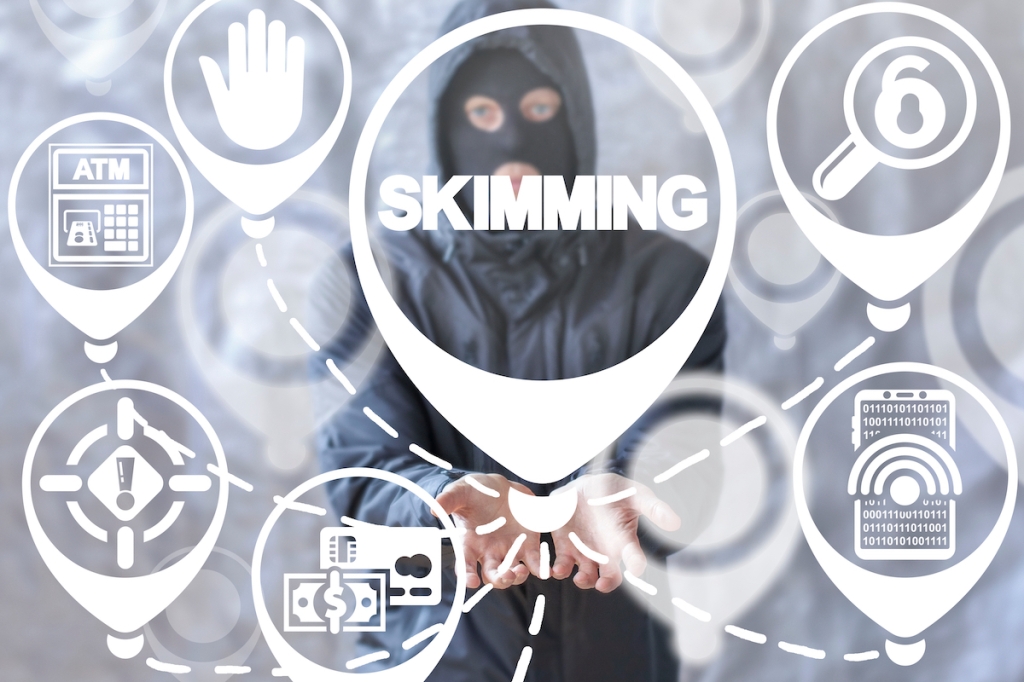
Card skimming is a technique criminals use to collect data from your credit or debit cards magnetic strip when you use it to pay for a purchase. Point-of-purchase machines, such as gas pumps, ATMs, and store check outs are susceptible to skimming devices.
According to the data analytics firm FICO, skimming scams are on the rise. They found a 96% increase in these scams in 2023. According to the FBI, skimming scams cost consumers upwards of a billion dollars a year in the United States.
How Skimming Occurs
Criminals install skimming devices on payment platforms, the device can be inserted into the card reader, or overlayed on the payment device. Sometimes a small camera is installed that records your activity. The skimming devices record the debit or credit card information. Depending on the type of device installed it can transmit data wirelessly or the thief will come back later to retrieve the data.
How to Spot a Skimming Device
Card skimming devices can be difficult to spot. Before making a payment inspect the payment terminal, signs of tampering can include a loose, misaligned or damaged card reader.
Part of the machine may look different than the rest, or the keypad may have an overlay. If the numbers are hard to press or you cannot see the numbers clearly that can indicate an overlay.
Gas pumps should have an intact security seal near the card reader. If the seal is broken, the FTC says the label will read void. Check other gas pumps to see if they look the same. If something looks different that may be a sign that a skimming device has been installed.
How to Prevent Skimming
Inspect each card reader you use, if anything seems out of place don’t use it and inform the business.
Check for hidden cameras near payment terminals and if you need to enter a PIN number cover the keypad with your hand while you type it in.
Avoid using your debit card when making a payment, use a credit card instead. Credit cards offer more protection, and they are not tied directly to your bank account.
Use a contactless payment method “tap to pay,” by tapping your card at the POS terminal. Each tap generates a transaction-specific, one-time code that can help reduce fraud. This near-field communications (NFC) technology is more secure since it does not expose the card’s magnetic stripe.
Use a mobile wallet like Apple Pay, Samsung Pay, or Google Pay. This form of payment is secure because your credit card information is tokenized.
Avoid outdoor terminals when possible, criminals are less likely to tamper with payment terminals located inside of a building.
Use a fuel pump located closest to the store, criminals often target fuel pumps that are not easily seen by store employees.
Avoid using non-bank ATMs. FICO reports that 60% of skimming occurs at privately-owned ATMs.
Regularly monitor your financial accounts so that you are quickly aware of any unusual charges or activity. Contact your financial institution immediately if you find a problem.
Sign up for account alerts at your bank, credit card company and other financial institutions. Alerts will notify you of any unusual or suspicious activity.
What To Do If Your Card Has Been Skimmed
If your debit or credit card has been compromised, contact your credit card company or bank immediately. Federal law limits your liability if a credit, ATM, or debit card is lost or stolen but you must report the loss as soon as possible. You will not be held responsible for charges made without your permission if they happen after you report the loss.
After reporting the loss immediately follow up in writing, send a letter to the bank or credit card company detailing the event, include the date the incident occurred, the date you reported it, your name, address, phone number, and account number.
